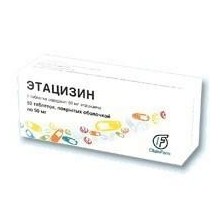



Ethacizine - an antiarrhythmic agent of the IC class, has a long antiarrhythmic effect. Inhibits the rate of rise of the front of the action potential (Vmax), does not change the resting potential. Depending on the dose, it can reduce the duration of the action potential. Does not change significantly effective refractory periods of the ventricles and atria. Inhibits fast incoming sodium current and, to a lesser extent, slow incoming calcium current.
Ethacizine slows down the conduction of excitation along the myocardial conduction system. Prolongation of the PR interval and the QRS complex appears on the ECG; the ST interval, reflecting the repolarization of the ventricles, does not change or has a tendency to shorten.
Ethacizine raises the myocardial fibrillation threshold. Unlike many antiarrhythmic drugs, Etizizin does not cause a significant decrease in the heart rate or prolong the QT interval on an ECG.
The antiarrhythmic effect when administered orally usually develops on the 1-2 day, the duration of the course of treatment depends on the form of arrhythmia, the effectiveness and tolerability of the drug.
Pharmacokinetics
When ingested, it is rapidly absorbed from the gastrointestinal tract and is determined in the blood after 30–60 minutes. Cmax in blood plasma is achieved in 2.5-3 hours. Bioavailability is 40%. 90% is bound to plasma proteins. T1/2 is 2.5 hours. The pharmacokinetics of Ethacizine are subject to significant individual fluctuations and require individual study in individual patients to determine the optimal concentration of the drug in the blood plasma. Intensively metabolized during the "first pass" through the liver. Some of the resulting metabolites have antiarrhythmic activity. From the body Ethacizine excreted by the kidneys in the form of metabolites. Ethacizine crosses the placental barrier. It is excreted in breast milk.
1 coated tablet contains:
active substance: Ethacizine (Ethacizine hydrochloride) 50 mg,
Excipients: potato starch - 9.57 mg; sucrose - 19.3 mg; methylcellulose - 0.33 mg; calcium stearate - 0.8 mg,
shell: sucrose - 37.695 mg; Povidone - 0.753 mg; quinoline yellow dye (E104) - 0.025 mg; dusk “sunset” yellow (Е110) - 0.003 mg; calcium carbonate - 6.308 mg; magnesium hydroxycarbonate basic - 3.678 mg; titanium dioxide (E171) - 0.665 mg; silicon dioxide - 0.827 mg; Carnauba wax - 0.046 mg.
No customer reviews for the moment.
For oral use regardless of the meal. The initial dose is 50 mg (1 tablet) 2-3 times a day. With insufficient clinical effect, the dose is increased (under the obligatory ECG control) to 50 mg 4 times a day (200 mg) or 100 mg 3 times a day (300 mg).
Upon reaching a persistent antiarrhythmic effect, maintenance therapy is carried out in individually selected minimum effective doses.
From the CCC: arrest of sinus node, AV block, abnormal intraventricular conduction, reduction of myocardial contractility, reduction of coronary blood flow, arrhythmia (arrhythmogenic effect most likely after myocardial infarction and in other types of cardiac pathology leading to a decrease in contractility of the heart muscle and the development of heart failure).
ECG changes: prolongation of the PQ interval, expansion of the P wave and the QRS complex.
From the side of the central nervous system: dizziness, headache, staggering when walking or turning the head, slight drowsiness; in some cases - diplopia, accommodation paresis.
From the digestive tract: nausea.
Perhaps a decrease in side effects or their disappearance after the use of the drug within 3-4 days. With long-term treatment with Etacizin, they do not increase, and with the discontinuation of the drug, they quickly disappear.
Side effects depend on the size of the dose and, to avoid them, you should not prescribe the maximum dose of the drug.
With extreme caution: with sick sinus syndrome, bradycardia, AV block I degree, coronary artery disease, severe disorders of the peripheral circulation, chronic heart failure I FC, angle-closure glaucoma, BPH, cardiomegaly (increased risk of arrhythmogenic action), electrolyte imbalance (hypokalemia, hyperkalimia, increases, arrhythmogenic action) , hepatic / renal failure.
Contraindicated with the use of other antiarrhythmic drugs IC (moracizin, allapininom, propafenone) and IA (quinidine, procainamide, disopyramide, aymalin) class.
Ethacizine should not be administered simultaneously with MAO inhibitors.
The combination of beta-blockers with Ethacizine may enhance the anti-arrhythmic effect, especially in relation to arrhythmias provoked by exercise or stress.
As well as other antiarrhythmic drugs, Ethacizine can act arrhythmogenically. Therefore, when appointing Etazizin should:
Risk factors for artimycin etizizin are considered: organic heart damage (especially - myocardial infarction), reduced left ventricular ejection fraction, the maximum dose of the drug. In addition, care should be taken in patients with liver disease. When treating Ethacizine can not drink alcohol.
During therapy, it is necessary to regularly monitor the patient’s condition and cardiovascular function (ECG, blood pressure, echocardiography).
Influence on ability to drive a car or perform work requiring an increased rate of physical and mental reactions. Due to the risk of dizziness during treatment, it is not recommended to drive vehicles or maintain complex mechanisms that require increased attention and ability to concentrate.
Ethacizine has a small therapeutic breadth, so severe intoxication can easily occur (especially with the simultaneous use of other antiarrhythmic drugs).
Symptoms: elongation of intervals PR and expansion of the complex QRS, increased amplitude T-wave, bradycardia, sinoatrial and AV block, asystole, paroxysms polymorphic and monomorphic ventricular tachycardia, decreased myocardial contractility, persistent reduction in blood pressure, dizziness, blurred vision, headaches, gastrointestinal disturbances.
Treatment: symptomatic; For the treatment of ventricular tachycardia, do not use antiarrhythmic agents of IA and IC classes; sodium bicarbonate is able to eliminate the expansion of the QRS complex, bradycardia and arterial hypotension.
Studies and clinical trials of Ethacizine (Click to expand)